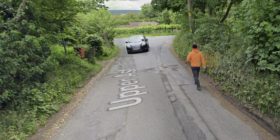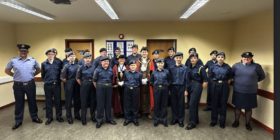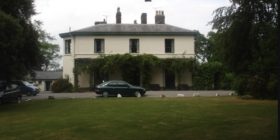The amazing wartime story of Queensferry’s Wilfred Ketland – a man who fought under 3 flags in WWII

Wilfred Ralph Ketland, Gunner in the Royal Artillery, partisan fighter in Poland and Red Army soldier on the Eastern Front, killed more than 100 Germans during five years of amazing adventures in Central Europe.
After failing four times to escape from a POW camp in Germany he succeeded at the fifth attempt, outwitted every trap set for him and became to the Germans another escaped “kriegsgefangener”. But to his parents in England he was dead for 19 long months when there came no word from him, and in the records of the Red Cross he was just another name on the growing list of those who had vanished.
Ketland’s extraordinary travels began on 11 June 1940 near St. Valery. His regiment, the 101 Light AA and A/Tk Regt, was struggling to the coast with heavy casualties even as the Germans swept past in their victorious drive to the sea. By nightfall all hope of escape had been given up, and the next morning Ketland joined with his comrades in carrying those who could no longer walk to the cliff tops. It was that morning that the weary remnants of the 101st, outnumbered and caught between the English Channel and the German Artillery, surrendered.
A day later the Germans began to march their prisoners along the battle-scared road to Holland. It was a forced march, at 30 sometimes 40 miles a day. The survivors, some of them wounded and all with the filth of battle still upon them, were given a few biscuits and thin watery soup. This was a diet for exhaustion, and when men faltered they were shot. There were many who died upon that road.
March to Captivity.
“No man who was on that march will ever forget it,” said Gnr. Ketland, relating his experiences at his home in Queensferry near Chester. “I believe someone has written a book about it, but no writer could have described the utter misery of those 22 appalling days.
In Holland the prisoners were loaded on to barges. Ketland, with 1000 others, were forced to sit in a cramped position with his knees touching his chest for three days and nights during the journey by canal into Germany. They were given food but no water, and so Ketland scooped water from the canal with his bare hands. The next stop, a German barracks, was no more than a three day halting place until Ketland was forced into a cattle truck and sent by train to Poland. Eventually he arrives at Stalag XXA. “In that camp,” he said “there were 10,000 men of varied nationality.”
“We stayed there for two months, and the routine was the most depressing part of all. After reveille at 5.30 and a cup of coffee we were ordered out on to the ramparts of the old fort — which was our prison — for the whole of the morning. There was nothing to do but the normal camp fatigues, and at one o’clock we went for our main ration of soup. In the afternoon it was the same thing again, until at 4.30 we drew bread and jam for our last meal. On the whole the Germans there treated us fairly enough.”
The Bluff Succeeded.
In September Ketland left the camp to work in the salt mines at Menteroda. For six weeks he worked underground with a maintenance gang. Later he was transferred to the surface factory. All the prisoners on this work received extra food. “We had the normal German civilian’s rations,” said Ketland. “It was a hard grind and even the Germans realised that we couldn’t carry on if they starved us.”
Ralph Ketland worked in the Menteroda salt mines for four years, and four times he tried to escape. Every plan he made went wrong. Each time the Germans brought him back and wondered what it was that made this small, Quiet-voiced English soldier so persistent. Ketland, searching for another and better plan of escape, decided to bluff the entire camp for the fifth attempt, and it worked.
His new plan was quite simple. He began to realise why all his previous schemes had failed. Each time a man escaped, all the Germans in the neighbourhood took part in the man-hunt, and they went on until either the prisoner was caught or they tired of the search. But suppose he pretended to escape? Suppose he let the Germans believe that he got away when in reality he hadn’t? When he wasn’t found the search would be abandoned and that would be the time to go.
On this theory Ketland hid in the wagon the whole of the seven days, and he did not leave it until the last of his water was gone. Then he was at a place called Tomaszow in mid-Poland. He approached a Pole, told him the whole story and explained his original idea of linking up with the Soviet armies at Lublin. After talking with the local population he found that this was impossible. Next day he was invited to join a group of local partisans.
Thus it was that Ralph Ketland took to the Polish forests and lived with an underground army. “At first,” he said “no one would trust me and the whole time during the first few weeks they regarded me with suspicion. Only after a number of operations was I accepted as a comrade.
In all there were about 100 of us, and we were armed to the teeth. New weapons and ammunition came down at night — from the sky. Small anti – tank guns floated down to us on the end of parachutes, for the RAF supplied us with nearly all we required. They dropped money and clothes and medical supplies. They brought us pocket radio sets and hand grenades. The whole organisation was magnificent. I heard that the main group of partisans, of which we were a section, was commanded by a lieutenant — colonel in the British army, but I never saw him myself.”
No Quarter.
“Normally I was armed with a Bren gun, hand grenades and revolver, not to mention bayonets. We needed all we could get.”
Ketland, who estimated that he himself killed more than100 Germans while fighting with the partisans, took part in dozens of operations against the neighbouring enemy. Sabotage, ambush and armed hold — ups were a weekly routine.
“It was a merciless business,” he said, “but we had become merciless men against a ruthless enemy. One of our favourite tricks was the ‘fake breakdown’ on a main road to the Russian front. A couple of us would dress up as a German officer and staff car driver, block the road with a captured vehicle and wait for a German convoy. While it came guarded by a few tanks, our ‘German officer’ would stop the column and immediately dash for cover. Then we let them have it. About 80 of us would be hiding along the road in the forest, and most of us had automatic weapons of some sort.”
“If thing went well for us we took what was left of the supplies, or destroyed war materials. If they escaped our barrage and made things to hot, we had to run for the woods, taking what wounded we could carry, and then it was not so good. We had few doctors for major operations, and medical supplies were one of our worst problems.”
But there came an end to this war of hide — and — seek among the Polish forests. Ketland’s group was badly smashed during a raid, and so many were wounded that it was decided to disband until the men had recovered. The partisans went back to their homes.
“But I was left,” continued Ketland a bit ruefully, “because I had no home to go back to. And it would have been dangerous to live with the partisans in their own villages. It was then that I decided to reach the Red Army whatever happened.”
Ketland’s luck still held. A few days later, on 15 January 1945, the Russians opened a new offensive, and their patrols moved nearer and nearer to where Ketland was hiding. Finally he was able to contact a Russian unit. He was taken to a Soviet officer who heard his story and believed him. When they found Ketland had been a Gunner, he was placed in command of a British 25-pr gun and promoted to sergeant immediately. The Russian offensive, rolling on to the river Oder, carried a new recruit with it, and Ralph Ketland fought with 152 Russian Brigade all the way.
Displaced Person.
It was at this point that a series of new troubles arose for Ketland. Caught up in the great stream of humanity wandering aimlessly back through Poland and towards Russia he lost contact with 152 Brigade, which had promised to send him home by air. The area in which he found himself contained hundreds of Germans on their way to Russian prison camps, bands of Polish partisans in search of their homes, and white Russian collaborators trying to escape. One morning, in spite of his protests, he was arrested by Soviet troops in a great round up and found himself on the 250 — mile march to Cracow.
Here he was interviewed by Soviet officers and his papers taken for inspection by security officials, but before he saw them he was on his way to another camp at Stalino in the Ukraine. Here, after many further interviews, he was sent to an international dispersal camp south — east of Moscow, where men of 27 different nationalities were trying to prove their identity. Forty — five men in this camp claimed to either be British or American servicemen. “But from the look of them,” said Ketland, “they were not all that they pretended. Undoubtedly the Russians had many people on their hands whose identity could not be proved, and I was one of them.”
At the dispersal camp Ketland was interviewed again, this time by an officer of the Soviet security organisation —the NKWD — from Moscow, and a few days later he was sent to Frankfurt — on — Oder. From her he travelled to the Russian zone in Berlin.
“One day,” he said, “I happened to see a British officer of the Military Government. I went up to him, told him who I was and what had happened. He took me away in his car the same day to displaced persons camp in the British zone. Here I was questioned for almost 24 hours by security police and intelligence officers. After that they were convinced that I was Wilfred Ralph Ketland of the royal Artillery. In Berlin they put me on a plane and I was on my way home at last.”
Happy Return.
Ketland arrived in England in November 1945. He had fought with the old BEF in France with weapons which, compared with today’s equipment, had been almost antique, and he came home just in time for the first peace — time Christmas of the atomic age. At his home in Queensferry he received more than 75 letters congratulating him on his safe return. When he leaves the Army — he is in group 25 — he will return to his civilian job of shop keeping.
How many other British soldiers have lived to tell of a one — man war under three flags?
Written by one of Wilfred Ketland’s relatives Sidney Watkinson and sent to the BBC for their WW2 Peoples War archive by Colin Eckersley
Spotted something? Got a story? Send a Facebook Message | A direct message on Twitter | Email: News@Deeside.comLatest News









